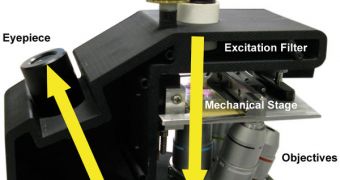A team of experts at the Rice University has recently developed a smaller, more compact, battery-operated version of the large fluorescence microscope used in research laboratories. Their machine has the same capabilities as its larger counterparts, but can be deployed at any location its handlers want, and then packed and shipped elsewhere when its job is done. In a paper published in the August 4 online issue of the esteemed open-access scientific journal PLoS ONE, the Rice team details how their innovation could impact the medical world.
The new microscope has been priced at just $240, and weighs just 2.5 pounds. The main idea behind the instrument was designing a medical tool that could be of tremendous use in clinics and hospitals in the developing world. In some countries, Rice researchers learned, even access to electricity is problematic, and this is why the new fluorescence microscope can be powered by batteries. Rice alumnus Andrew Miller was the main investigator on this project, which began as his senior design project last year. The expert is based at the Rice 360˚: Institute for Global Health Technologies.
Fluorescence microscopes are extremely efficient at diagnosing a variety of conditions, most notably tuberculosis (TB). The $240 portable version of the tool has been constructed in such a way that it can easily go up against larger, much more expensive instruments, can are usually sold for as much as $40,000. Miller, who also works at the Methodist Hospital Research Institute (TMHRI), used his newly-developed Global Focus microscope on a batch of patients he and colleagues suspected had TB.
Their instrument proved just as effective as standard fluorescence microscopes in detecting signs of the condition. In the PLoS ONE paper, the team reveals that the two types of microscopes agreed in their diagnostics in 98.4 percent of cases. The Global Focus microscope has already elicited a lot of attention, as evidenced by the fact that it already won this year's Hershel M. Rich Invention Award.
“The World Health Organization estimates that 1.3 million people died from tuberculosis in 2008. Andy's microscope, which is portable, durable and inexpensive, could be used to diagnose tuberculosis in community or rural health centers with limited infrastructure in the developing world, promoting early detection and successful treatment of the disease,” says the founding director of Rice 360°, expert Rebecca Richards-Kortum. She is also the Rice Stanley C. Moore Professor of Bioengineering.

 14 DAY TRIAL //
14 DAY TRIAL //